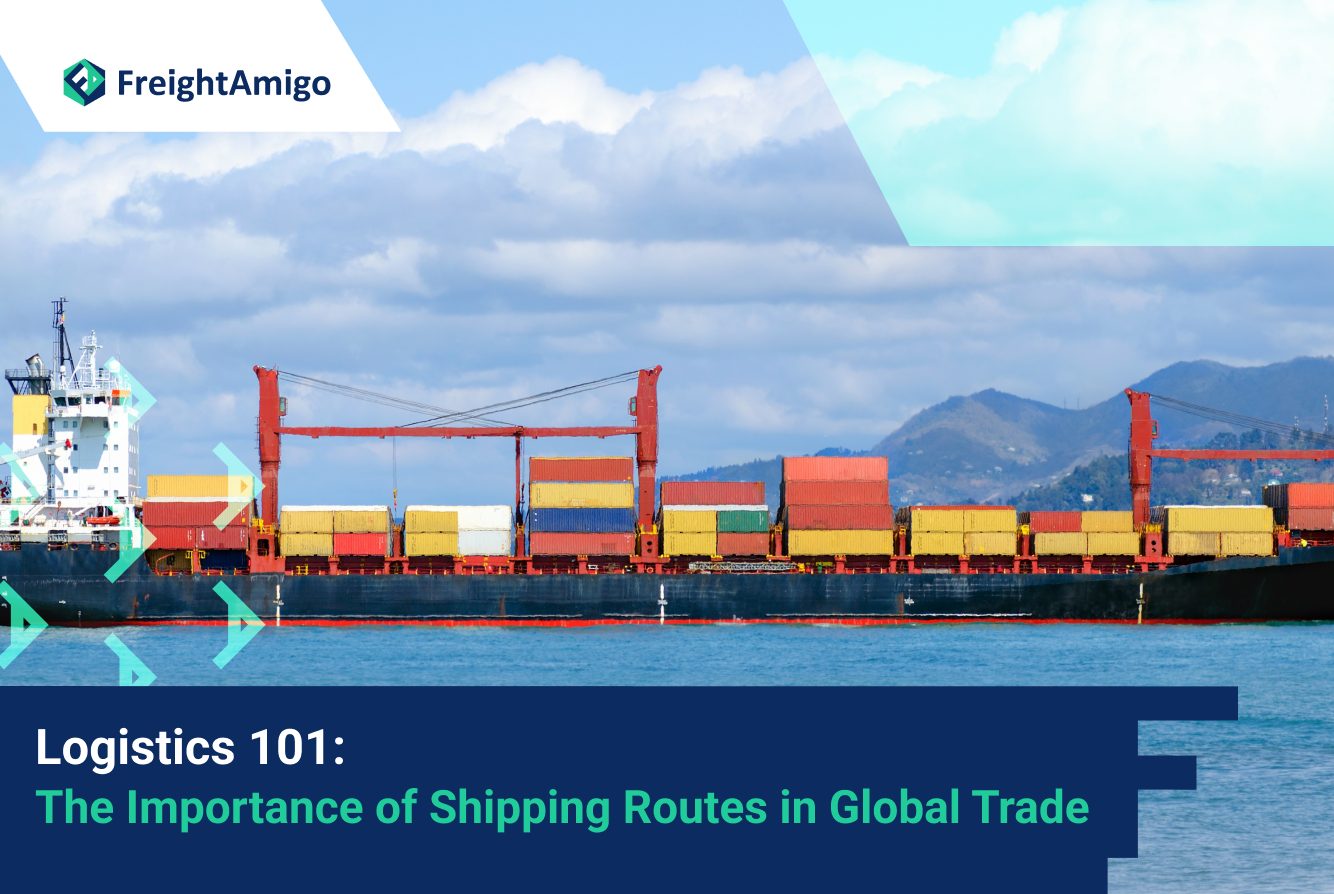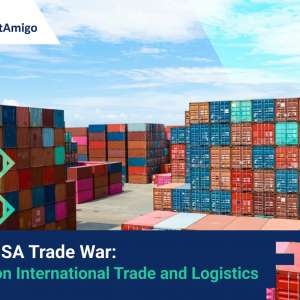Author Name: Tiffany Lee – Marketing Analyst at FreightAmigo
Shipping routes play a crucial role in facilitating global trade, connecting nations and enabling the transportation of goods across continents. These routes serve as lifelines for economies, allowing for the movement of essential commodities, raw materials, and finished products. Understanding the significance of shipping routes is essential for businesses and logistics providers like FreightAmigo, who leverage their expertise and global network to optimize these routes and ensure efficient and cost-effective transportation of goods.
Want To Compare The Best Express, Air Freight, Sea Freight, Rail Freight & Trucking Rates So As To Have Better Control On Cost?
What are the most strategical shipping routes in the world?
The Dover Strait or English Channel
One of the major shipping routes in the world is the Dover Strait, also known as the English Channel. This vital waterway connects the North Sea and the Atlantic Ocean, serving as a critical link for trade between European countries and the United Kingdom. Approximately 25% of trade between these regions occurs through this channel, making it a key route for businesses.
Every day, an estimated 500 ships navigate through the Dover Strait, carrying 22% of British imports from the European Union and 30% in the opposite direction. The channel’s strategic location makes it a popular choice for transportation, facilitating the movement of goods and fostering economic growth.
The Strait of Malacca
Another significant shipping route is the Strait of Malacca, located near Indonesia, Malaysia, and Singapore. This strait connects the Pacific and Indian Oceans, making it the main shipping lane into and out of Asia. It also serves as a crucial intra-Asia route, linking the region’s major economies such as India, China, and Japan, along with countries like Thailand, Indonesia, Malaysia, Philippines, Singapore, Vietnam, Taiwan, and South Korea.
Over 83,000 vessels pass through the Strait of Malacca annually, accounting for approximately 40% of global sea traffic. Its strategic position as the shortest pathway between the Persian Gulf and Asia makes it a vital route for the transportation of energy products, particularly for China. In fact, around 61% of global petroleum production transported by sea crosses this key trade checkpoint for oil.
The Panama Canal
The Panama Canal is an artificial seaway that serves as the number one shipping trade route connecting Asia and the US East Coast. This direct lane between the Atlantic and Pacific Oceans sees nearly 14,000 vessels pass through it each year. The Panama Canal’s strategic importance lies in its ability to significantly reduce travel distances for ships, saving both time and costs.
By leveraging the Panama Canal, businesses can efficiently transport goods between the East Coast of the United States and Asia, providing a vital trade link that facilitates global commerce. The canal’s efficient operations and infrastructure make it a preferred choice for shipping companies and logistics providers.
The Suez Canal
The Suez Canal is one of the most popular and heavily used trade routes globally, located in the north-east of Egypt. This canal serves as the shortest sea route between Asia and Europe, crossing the Red Sea. Approximately 19,000 ships pass through the Suez Canal daily, accounting for 12% of global trade and 30% of global container traffic.
In addition to its role as a key trade route, the Suez Canal serves as the main regional shipping hub for the world’s oil, hydrocarbons, and liquefied natural gas. It facilitates the transportation of approximately 7-8% of global oil and 8% of liquefied natural gas from Asia and the Middle East to Europe. The canal’s strategic location and efficient operations make it an indispensable part of global trade.
The Danish Straits
The Danish Straits, including the Øresund, the Great Belt, and the Little Belt, play a vital role in facilitating trade between Russia and Europe. These key channels connect the North Sea and the Baltic Sea, providing a crucial gateway for goods transportation. The Danish Straits are strategic shipping routes that enable efficient trade flows, supporting economic development in the region.
The St. Lawrence Seaway
The St. Lawrence Seaway is an essential shipping route for cargo transportation between the United States and the upper regions of Canada. This waterway handles approximately 40 to 50 million tons of cargo annually, connecting major ports along the Great Lakes and the Atlantic Ocean. The St. Lawrence Seaway opens up crucial trade opportunities for businesses in these regions, ensuring the smooth flow of goods and fostering economic growth.
The Strait of Hormuz
The Strait of Hormuz, located between Oman and Iran, is a vital shipping route for the transportation of oil and gas. This narrow strait connects the Persian Gulf with the Arabian Sea, serving as a significant chokepoint for maritime trade. Approximately one-fifth of the world’s oil passes through this strait, making it a critical route for global energy supplies.
The Strait of Gibraltar
The Strait of Gibraltar, situated between Spain and Morocco, plays a crucial role in connecting the Atlantic Ocean with the Mediterranean Sea. This shipping route serves as a gateway for trade between Europe, Africa, and the Americas. It facilitates the movement of goods, including petroleum products, between these regions, supporting economic activities and international trade.
The Bosphorus Strait
The Bosphorus Strait, located in Turkey, is a vital passage connecting the Black Sea with the Mediterranean Sea. This shipping route enables trade between Europe, Asia, and the Middle East, serving as a crucial link for maritime commerce. The Bosphorus Strait plays a significant role in facilitating the movement of goods, contributing to regional economic integration and global trade flows.
Enhancing Global Trade through Shipping Routes
Shipping routes are the backbone of global trade, enabling the efficient transportation of goods across continents. Businesses like FreightAmigo leverage their expertise and partnerships to optimize these routes, ensuring cost-effective and timely delivery of goods. By strategically coordinating with shipping carriers and streamlining supply chains, FreightAmigo enables businesses to access reliable shipping options, expand their global reach, and enhance their competitiveness in the international market.
Through their comprehensive logistics solutions and global network, FreightAmigo facilitates the transportation of goods along major shipping routes. They understand the significance of these routes and work closely with businesses to optimize their supply chains, ensuring smooth operations and efficient delivery. With their expertise and dedication, FreightAmigo plays a pivotal role in supporting global trade and fostering economic growth.
There Are Different Options For Cargo Transportation. If You Want To Choose The Most Convenient And Suitable Solution, It Is Best To Have The Full Support Of Logistics Experts! If You Are Planning To Ship Goods Overseas, Please Go To The FreightAmigo Page For Inquiries.
===
Read More:
【E shop+】Become an online shop expert!Learn more about the online shipping channels here
【Logistics News】Panama Canal Celebrates its 108th Anniversary
===
If you have any inquiries on logistics/supply chain, feel free to contact FreightAmigo now:
Chat with us online OR
Phone : +852 28121686
WhatsApp: +852 27467829



